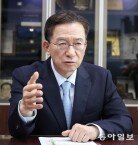Weak Won Fueling Boom at Markets Catering to Foreigners
Weak Won Fueling Boom at Markets Catering to Foreigners
Posted December. 08, 2008 05:16,
The exchange rates for the Korean won against the U.S. dollar and the Japanese yen flickered in red lights on an electronic display board in the hallway of a fashion mall in Dongdaemun Market in eastern Seoul on Sunday night.
The won-dollar rate was 1,475.5 and that for the won per 100 yen was 1,599.63.
A steep fall in the wons value coinciding with the global financial crisis has changed the landscape of Dongdaemun Market, the center of Koreas fashion industry. The number of foreign customers has markedly increased while domestic buyers have almost disappeared.
○ Russian merchants return
Russian buyers have returned to the market in full force. In the mid-1990s, they thronged to Dongdaemun in large numbers and formed a Russia Town near the now-demolished Dongdaemun Stadium.
A wholesaler near Dongdaemun Stadium subway station said, Russian merchants have come back after 10 years. Its true that handy carry trade goes against the economy. The falling won has brought in new foreign merchants.
The sharp decline in the wons value has reduced the prices of goods almost 75 percent. Russian dealers are taking advantage of the price fall.
A third-generation Russian Korean who sells socks and stockings wholesale to Russians said, The number of Russian buyers has increased 10 percent. Due to small traders coming from Moscow and Vladivostok, sales have jumped.
○ Spendthrift Japanese invigorate market
Lavishly spending Japanese tourists are also helping business in the area flourish.
The Japan Association of Travel Agents said the number of Japanese visitors to Korea this month has grown 68 percent from a year ago. Dongdaemum Market is a must-visit destination for Japanese tourists, who can buy clothes at half price due to the strong yen.
Compared to August and September, the number of Japanese tourists more than doubled in October and November. We are doing well despite the slowdown in the economy thanks to more Japanese travelers, said Jeon Jang-soo, head of marketing team at the shopping mall Doota.
A store owner at the shopping mall Milliore said, At a time when domestic consumption has almost frozen, Japanese tourists who buy goods worth 200,000 to 300,000 won (136 to 203 U.S. dollars) are a boon to me. To attract more Japanese, I am learning Japanese.
To lure more Japanese shoppers, shopping malls have set up information desks and brochures for Japanese.
Among foreign buyers from countries including China, Britain, the United States, Jordan and Japan, Japanese buyers account for 90 percent. They are the lifeline for Dongdaemun Market, said Goh Dong-cheol, head of the information center for foreign buyers.
○ Distribution sector scrambles to draw foreigners
The situation is the same for shopping malls in other areas and large discount stores. The distribution industry has stepped up efforts to attract foreign customers.
IParkmall, located near areas having large numbers of foreign residents such as Hannam-dong and Itaewon, has increased the number of foreign-language announcements. Announcements in English, Japanese and Chinese have grown from five times a day in August to 10. Foreign currency exchange services are provided not only for the U.S. dollar and euro but also the Japanese yen and the Chinese yuan. Customers can pay in dollars or euros as well.
Lotte Mart by Seoul Station has interpreters for Japanese customers who come to buy Korean food such as seaweed and kimchi. More than half of our foreign customers are Japanese, a Lotte Mart said. We have expanded the stand for seaweed and set up stands for traditional Korean souvenirs.
constant25@donga.com swon@donga.com







